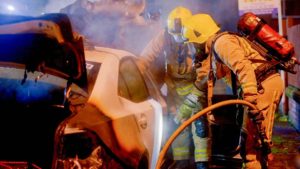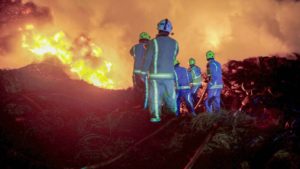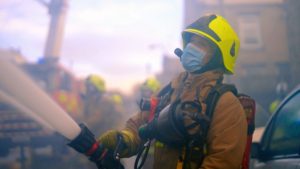A four-part documentary series on Yorkshire’s Firefighters is currently airing on the BBC, taking us onto the frontline with the men and women keeping their communities safe during the pandemic.
We sat down with crew commander of Dewsbury Fire Station, one of the stars in the documentary, Asif Mahroof, 42, to ask what it is like working in fire and rescue and how he manages to keep a good work-life balance.
Kirklees native and father-of-three Mr Mahroof has worked with West Yorkshire Fire and Rescue Service for the last fifteen years, rising to crew commander three years ago.
Describing how he first got into the role, Mr Mahroof said: “The opportunity cropped up. I never really gave it a thought, to be honest with you.

It wasn’t until it came up in conversation at my previous job where a colleague of mine was thinking of joining. so I decided to phone up the local station and go down for a bit of a taster.
I met the shift leader and spent time doing a bit of practical work, liked what I saw and then applied”.
To reach crew commander level, you have to first work as a firefighter. There are no required years of service before becoming a commander, except for completing the probation period and have a clean record within the organisation.
Mr Mahroof said: “I didn’t apply for the crew commander role until twelve years into the job as a firefighter because, for me, I enjoyed my role very much and don’t feel the pressure to do things I wasn’t ready for, and the organisation allows you to go at your own pace. I transitioned from fire to crew when I did because I felt ready.”
In his role as crew commander, Mr Mahroof balances managerial work, with leading a team, attending to 999 emergencies, as well as working within the wider community to prevent fires and to improve safety knowledge.
Mr Mahroof leads a team of firefighters, ensuring they meet their individual and group objectives, as well as contributing to fire safety solutions to minimise risks in the community and informing and educating the community to improve awareness of safety.

The hours of a firefighter are long, with even more responsibility for a commander.
The beginning of the shift starts with a parade, which is where the crew are told their duties for the day which include routine tasks such as checking over appliances and ensuring that equipment such as cutting gear and first aid items are all in good working order.
This is then followed by operation training, which is different each day. This ensures that the firefighters are always up-to-date with their training and keeps knowledge fresh.
Following this is fire prevention checks out in the community, where Mr Mahroof will call into homes and businesses to make sure that fire alarms and other safety precautions are being correctly followed.
These home visits might sound mundane, but getting out into the community and speaking to people is one of Mr Mahroof’s favourite parts of the job. He said: “The social aspect of the job is what I really enjoy, going into the community. It is a social and mental fix for me as well.”
When not in a global pandemic, Mr Mahroof would organise taster days at the firehouse where local schools and organisations can go down to the station to experience what it is like to work in the fire and rescue team.

Speaking about this Mr Mahroof said: “Usually we get schools and groups to come down to the firehouse quite regularly but in the past 18 months we have been unable to do so but we’re looking forward to reintroducing them in the future.”
Living near the fire station means that Mr Mahroof serves the community that he lives in, which means that there is a possibility that the addresses of friends and family may pop up in an emergency. He said: “We know where we are going every time an emergency pops up in the area but it would be your worst nightmare seeing the address of a loved one on the call out.”
For Mr Mahroof, the scariest moment on the job is when a loss of life occurs. He said: “You always think about if and what you could have done differently, and if you did do it, would the outcome be any different? It is those kinds of moments that I remember the most.”
Keeping a healthy work-life balance can be difficult in this line of job, but maintaining boundaries is a good way of making sure that work doesn’t become consuming. “When I’m at work, I’m at work and when I’m home, I’m at home,” he says. He also goes on to say that “Sometimes in this job, you do have to leave early from events or skip out on them all together because you have to work evenings or night shifts at the station, but I get to be with my kids at other times, dropping them off at school for example.
“I also never experience a busy supermarket because it is always quiet during the week. Having three kids and a wife who has been with them all day is also a good way not thinking about work when I am home.”
Protecting the mental health of key workers through the pandemic has emerged as one of the main issues in the past year and a half, for Mr Mahroof, maintaining a happy team who want to come to work has been the way of keeping mental health issues at bay.
Representation of South Asian and other ethnic minorities in the fire service is important. Seeing faces that represent you goes a long way in community cohesion. Mr Mahroof said: Since I started there have been more people from ethnic minorities join the team.
“We are always looking for more young people to join the fire service. Young people can do this by phoning up their local station and asking how they can get involved. They can also take a look at our social media and website on how to join up officially.”
The remaining two episodes of Yorkshire’s Firefighters is on Thursday 12 August and Thursday 19 August on BBC Two, with previous episodes available on catchup on BBC iPlayer.
For more information on how to join get involved with West Yorkshire Fire and Rescue, you can visit here.




